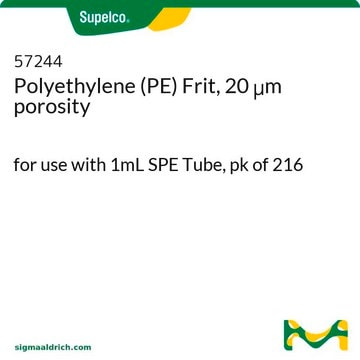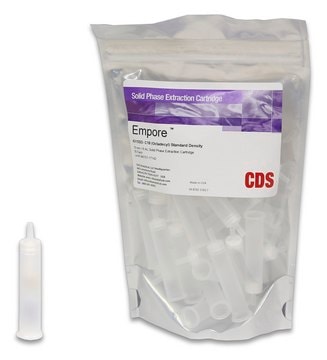55508-U
Discovery® Glycan SPE Bulk Packing
pkg of 50 g
Sign Into View Organizational & Contract Pricing
All Photos(1)
About This Item
UNSPSC Code:
41115712
NACRES:
NB.21
Recommended Products
packaging
pkg of 50 g
Quality Level
technique(s)
solid phase extraction (SPE): suitable
impurities
<5% Water content
matrix
polyamide resin base material
matrix active group
amide, poly- phase
particle size
50-160 μm
pH range
4.5-7.5(surface pH)
bulk density
0.2‑0.3 g/mL
separation technique
reversed phase
Related Categories
General description
Retention Mechanism: Reversed-phase
Sample Matrix Compatibility: Aqueous or methanolic solutions
Sample Matrix Compatibility: Aqueous or methanolic solutions
- Polyamide Resin: Particle Size: 50-160 μm, Surf pH: 4.5-7.5, Density: 0.2-0.3 cm3/g, Water Content: < 5 %
- Useful for extracting gylcans from aqueous solutions.
- Used to adsorb polar compounds (-OH groups, esp. phenolic compounds) from aqueous or methanolic solutions under the reversed-phase mechanism through strong hydrogen bonding between compound hydroxyl groups and amide groups of the resin
- Also may be used for the extraction of tannins, chlorophyll, humic acid, pharmacologically active terpenoids, flavanoids, gallic acid, catechol A, protocatechuic acid, phloroglucinol, aromatic carboxylic acids, and nitroaromatic compounds
- Irreversibly retains quinones.
Legal Information
Discovery is a registered trademark of Merck KGaA, Darmstadt, Germany
Storage Class Code
11 - Combustible Solids
WGK
WGK 3
Flash Point(F)
Not applicable
Flash Point(C)
Not applicable
Choose from one of the most recent versions:
Already Own This Product?
Find documentation for the products that you have recently purchased in the Document Library.
Haley Shelley et al.
AAPS PharmSciTech, 19(6), 2554-2563 (2018-06-28)
Nepafenac is a nonsteroidal anti-inflammatory drug (NSAID), currently only available as 0.1% ophthalmic suspension (Nevanac®). This study utilized hydroxypropyl-β-cyclodextrin (HPBCD) to increase the water solubility and trans-corneal permeation of nepafenac. The nepafenac-HPBCD complexation in the liquid and solid states were
Hsin-Yuan Chen et al.
Cellular physiology and biochemistry : international journal of experimental cellular physiology, biochemistry, and pharmacology, 49(5), 1970-1986 (2018-09-21)
Uterine leiomyomas (ULs) are benign uterine tumors, and the most notable pathophysiologic feature of ULs is excessive accumulation of extracellular matrix (ECM). Fucoidan is a polysaccharide extracted from brown seaweeds that has a wide range of pharmacological properties, including anti-fibrotic
Evanna L Mills et al.
Nature, 556(7699), 113-117 (2018-03-29)
The endogenous metabolite itaconate has recently emerged as a regulator of macrophage function, but its precise mechanism of action remains poorly understood. Here we show that itaconate is required for the activation of the anti-inflammatory transcription factor Nrf2 (also known
Site-Specific Glycosylation of Virion-Derived HIV-1 Env Is Mimicked by a Soluble Trimeric Immunogen.
Weston B Struwe et al.
Cell reports, 24(8), 1958-1966 (2018-08-23)
Many broadly neutralizing antibodies (bnAbs) against HIV-1 recognize and/or penetrate the glycan shield on native, virion-associated envelope glycoprotein (Env) spikes. The same bnAbs also bind to recombinant, soluble trimeric immunogens based on the SOSIP design. While SOSIP trimers are close
Wei Liu et al.
Glycobiology, 28(6), 363-373 (2018-03-22)
O-linked N-acetylglucosamine (O-GlcNAcylation) is an important post-translational modification on serine or threonine of proteins, mainly observed in nucleus or cytoplasm. O-GlcNAcylation regulates many cell processes, including transcription, cell cycle, neural development and nascent polypeptide chains stabilization. However, the facile identification
Articles
Reversed-phase interaction will retain most molecules with hydrophobic character; it is very useful for extracting analytes that are very diverse in structure within the same sample.
Our team of scientists has experience in all areas of research including Life Science, Material Science, Chemical Synthesis, Chromatography, Analytical and many others.
Contact Technical Service





